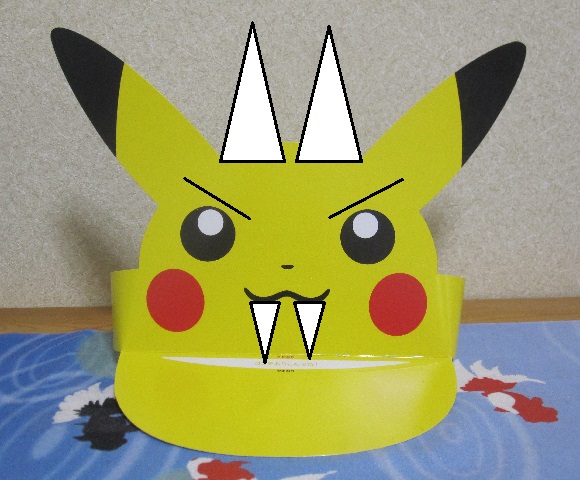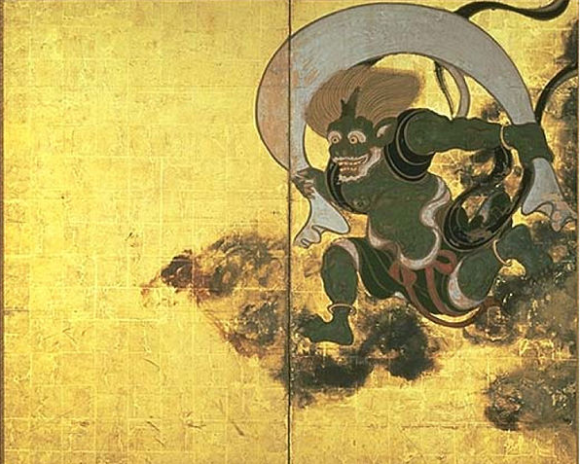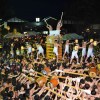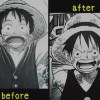
Also, Pokémon character designer reveals that his name is NOT supposed to mean “electric mouse.”
Close your eyes and imagine Pikachu (oh, and also remember to open your eyes back up again so you can continue reading this article). You can see him clearly in your mind’s eye, right? That cuddly build, friendly smile, and rosy cheeks are just the ultimate in disarmingly cute character design, aren’t they?
Okay, now close your eyes again, and this time imagine Pikachu with fangs and horns.
Crazy as it might seem, 22 years after the release of Pokémon Red and Green, the initial installments of the video game series, those fearsome features really were part of the initial concept for Pikachu’s evolution path. Earlier this month, we learned that Pikachu, which evolves into Raichu, was originally planned to have a third evolutionary tier, and in a recent interview Pokémon Red and Green character designers Ken Sugumori and Atsuko Nishida shed more light on the lost Pokémon.
Following Raichu, Pikachu’s next evolution was going to be called Gorochu. “Goro” is a relatively common, if somewhat old-fashioned, Japanese men’s name with a bulky, masculine ring to it, and Gorochu was going to be suitably macho in design. The Pocket Monster would have had sharp fangs and horns protruding from his forehead. “He was going to look something like Kaminari-sama,” recalls Nishida, referring to a thunder deity (more formally called Raijin) often depicted in Japanese religious or mythological art.
▼ Pika…?
So why was Gorochu cut from the final version of the game? One reason was for gameplay balance, but another major factor was memory space. Pokémon Red and Green was made for Nintendo’s Game Boy, which was much more a workhorse than a powerhouse in terms of hardware specs. There wasn’t enough memory available in the cartridge for every Pokémon to have two evolutions, and since Pikachu wasn’t originally one of the selectable starter Pokémon, Gorochu was axed.
The technical limitations of the Game Boy also affected the Pikachu design itself. Ever wondered why the tips of Pikachu’s ears are black, as opposed to yellow like most of his body? Because the standard Game Boy had a black-and-white screen, and adding color to the tips of his ears made them more expressive by allowing artists to show which way they were pointing or leaning. Another bit of trivia: there’s no special significance to Pikachu’s Pokédex number being 25, as the game’s staff simply numbered the Pokémon in the approximate order they expected players to encounter them in when playing through the game.
While reminiscing about Pikachu’s origins, Nishida, who chose the character’s name, also dispelled the often-repeated explanation that Pikachu comes from pika (the Japanese onomatopoeia for a flash of light) and chu (the onomatopoeia for a mouse’s squeak). It turns out that popular theory is only half right; the “pika”/flash part is correct, but Nishida says she chose the “chu” simply based on its sound and length, reiterating that she never consciously intended to make Pikachu look like a mouse. “By the time I was designing Pikachu, we already had a mouse-like Pokémon with Rattata,” she says.
▼ Rattata
https://twitter.com/CallyMac666/status/997938798230212609But while Pikachu was never meant to be a cute mouse, he was undeniably cute. One of his earliest fans was Koji Nishino, a planner for Pokémon Red and Green. Nishino liked Pikachu so much that he actually got a little covetously protective, purposely lowering the encounter rate for the now-famous Electric-Type. In doing so, however, he inadvertently made Pikachu one of the first “rare” Pokémon players are able to find, making him all the more popular and helping to propel him to his status as the long-running series’ biggest star.
Source: The Pokémon Company via Hachima Kiko
Top image ©SoraNews24
Insert image: Wikipedia/Kca
Follow Casey on Twitter, where he’s finding having a sizable stash of Pikachu visors in his home to be quite handy.


 New Pokémon earrings and hair accessories will have you looking Pikachu-perfect
New Pokémon earrings and hair accessories will have you looking Pikachu-perfect Believe it or not, you already know every single lyric to the new Pokémon Pikachu theme song
Believe it or not, you already know every single lyric to the new Pokémon Pikachu theme song Brand new Pikachu donuts pulled from market for being too uncute to live【Photos】
Brand new Pikachu donuts pulled from market for being too uncute to live【Photos】 Pen-Pikachu-Apple-Pen? Pokémon star teams up with PPAP singer for new song
Pen-Pikachu-Apple-Pen? Pokémon star teams up with PPAP singer for new song Whole-Pikachu curry plates with Gen 1 starter buddies coming to Pokémon Cafe【Photos】
Whole-Pikachu curry plates with Gen 1 starter buddies coming to Pokémon Cafe【Photos】 McDonald’s new Happy Meals offer up cute and practical Sanrio lifestyle goods
McDonald’s new Happy Meals offer up cute and practical Sanrio lifestyle goods All-you-can-drink Starbucks and amazing views part of Tokyo’s new 170 meter-high sky lounge
All-you-can-drink Starbucks and amazing views part of Tokyo’s new 170 meter-high sky lounge Studio Ghibli glasses cases let anime characters keep an eye on your spectacles
Studio Ghibli glasses cases let anime characters keep an eye on your spectacles More foreign tourists than ever before in history visited Japan last month
More foreign tourists than ever before in history visited Japan last month Beautiful Sailor Moon manhole cover coasters being given out for free by Tokyo tourist center
Beautiful Sailor Moon manhole cover coasters being given out for free by Tokyo tourist center Super Nintendo World expansion gets delayed for several months at Universal Studios Japan
Super Nintendo World expansion gets delayed for several months at Universal Studios Japan Hamster abandoned at Tokyo ramen restaurant gets new home
Hamster abandoned at Tokyo ramen restaurant gets new home “Half-naked men only in loincloths” drum battle returns to Hida festival for first time in five years
“Half-naked men only in loincloths” drum battle returns to Hida festival for first time in five years Track the stylistic evolution of Eiichiro Oda’s most famous One Piece characters
Track the stylistic evolution of Eiichiro Oda’s most famous One Piece characters Hello Kitty isn’t a cat!? We called Sanrio to find out!
Hello Kitty isn’t a cat!? We called Sanrio to find out! Disney princesses get official manga makeovers for Manga Princess Cafe opening in Tokyo
Disney princesses get official manga makeovers for Manga Princess Cafe opening in Tokyo Starbucks reopens at Shibuya Scramble Crossing with new look and design concept
Starbucks reopens at Shibuya Scramble Crossing with new look and design concept Beautiful new Final Fantasy T-shirt collection on the way from Uniqlo【Photos】
Beautiful new Final Fantasy T-shirt collection on the way from Uniqlo【Photos】 Is the new Shinkansen Train Desk ticket worth it?
Is the new Shinkansen Train Desk ticket worth it? Foreign English teachers in Japan pick their favorite Japanese-language phrases【Survey】
Foreign English teachers in Japan pick their favorite Japanese-language phrases【Survey】 Japanese convenience store packs a whole bento into an onigiri rice ball
Japanese convenience store packs a whole bento into an onigiri rice ball We try out “Chan Ramen”, an underground type of ramen popular in the ramen community
We try out “Chan Ramen”, an underground type of ramen popular in the ramen community Studio Ghibli releases Kiki’s Delivery Service chocolate cake pouches in Japan
Studio Ghibli releases Kiki’s Delivery Service chocolate cake pouches in Japan Japan’s bone-breaking and record-breaking roller coaster is permanently shutting down
Japan’s bone-breaking and record-breaking roller coaster is permanently shutting down New definition of “Japanese whiskey” goes into effect to prevent fakes from fooling overseas buyers
New definition of “Japanese whiskey” goes into effect to prevent fakes from fooling overseas buyers Our Japanese reporter visits Costco in the U.S., finds super American and very Japanese things
Our Japanese reporter visits Costco in the U.S., finds super American and very Japanese things Studio Ghibli unveils Mother’s Day gift set that captures the love in My Neighbour Totoro
Studio Ghibli unveils Mother’s Day gift set that captures the love in My Neighbour Totoro Foreign passenger shoves conductor on one of the last full runs for Japan’s Thunderbird train
Foreign passenger shoves conductor on one of the last full runs for Japan’s Thunderbird train Domino’s Japan now sells…pizza ears?
Domino’s Japan now sells…pizza ears? New Japanese KitKat flavour stars Sanrio characters, including Hello Kitty
New Japanese KitKat flavour stars Sanrio characters, including Hello Kitty Kyoto creates new for-tourist buses to address overtourism with higher prices, faster rides
Kyoto creates new for-tourist buses to address overtourism with higher prices, faster rides Sales of Japan’s most convenient train ticket/shopping payment cards suspended indefinitely
Sales of Japan’s most convenient train ticket/shopping payment cards suspended indefinitely Sold-out Studio Ghibli desktop humidifiers are back so Totoro can help you through the dry season
Sold-out Studio Ghibli desktop humidifiers are back so Totoro can help you through the dry season Japanese government to make first change to romanization spelling rules since the 1950s
Japanese government to make first change to romanization spelling rules since the 1950s Ghibli founders Toshio Suzuki and Hayao Miyazaki contribute to Japanese whisky Totoro label design
Ghibli founders Toshio Suzuki and Hayao Miyazaki contribute to Japanese whisky Totoro label design Doraemon found buried at sea as scene from 1993 anime becomes real life【Photos】
Doraemon found buried at sea as scene from 1993 anime becomes real life【Photos】 Tokyo’s most famous Starbucks is closed
Tokyo’s most famous Starbucks is closed One Piece characters’ nationalities revealed, but fans have mixed opinions
One Piece characters’ nationalities revealed, but fans have mixed opinions We asked a Uniqlo employee what four things we should buy and their suggestions didn’t disappoint
We asked a Uniqlo employee what four things we should buy and their suggestions didn’t disappoint Princesses, fruits, and blacksmiths: Study reveals the 30 most unusual family names in Japan
Princesses, fruits, and blacksmiths: Study reveals the 30 most unusual family names in Japan Pokémon Gold and Silver Pocket Monsters finally added to Pokémon GO!
Pokémon Gold and Silver Pocket Monsters finally added to Pokémon GO! Life-size Pikachu figure that wirelessly charges electronics fills us with joy/jealousy【Video】
Life-size Pikachu figure that wirelessly charges electronics fills us with joy/jealousy【Video】 Wrinkly Pikachu cookies are the latest Japanese interpretation of Ryan Reynold’s CG Pikachu
Wrinkly Pikachu cookies are the latest Japanese interpretation of Ryan Reynold’s CG Pikachu New sleeping bag Pikachu plush toys coming to game centres in Japan this May
New sleeping bag Pikachu plush toys coming to game centres in Japan this May New Pikachu character coming to Pokémon anime series after Ash’s retirement
New Pikachu character coming to Pokémon anime series after Ash’s retirement Pikachu himself visits SoraNews24’s Tokyo office for the best workday EVER【Photos】
Pikachu himself visits SoraNews24’s Tokyo office for the best workday EVER【Photos】 Pokémon GO melds with Tokyo’s traditional neighborhood for Asakusa Routes event, gets thumbs up from us
Pokémon GO melds with Tokyo’s traditional neighborhood for Asakusa Routes event, gets thumbs up from us New posable life-size detective Pikachu plushie commits crime of stealing our hearts【Photos】
New posable life-size detective Pikachu plushie commits crime of stealing our hearts【Photos】 Detective Pikachu debuts in Pokémon GO in event saluting franchise’s first live-action film
Detective Pikachu debuts in Pokémon GO in event saluting franchise’s first live-action film Pikachu becomes a phone-charging butt plug in knockoff Pokémon merch from China
Pikachu becomes a phone-charging butt plug in knockoff Pokémon merch from China Sagamiko Illumillion Christmas light park opening soon, promises glittering Pokémon, light shows
Sagamiko Illumillion Christmas light park opening soon, promises glittering Pokémon, light shows Japan’s new Pokémon donuts are here, so let’s eat Pikachu, Chansey, and some Poké Balls【Photos】
Japan’s new Pokémon donuts are here, so let’s eat Pikachu, Chansey, and some Poké Balls【Photos】 Pokémon GO player claims his in-game snapshot shows Japan’s new emperor and Pikachu together
Pokémon GO player claims his in-game snapshot shows Japan’s new emperor and Pikachu together Pokémon: Detective Pikachu movie trailer surprises fans with first look at live-action characters
Pokémon: Detective Pikachu movie trailer surprises fans with first look at live-action characters “Electric Shock Warning! Electric shock Pikachu” released in Japan
“Electric Shock Warning! Electric shock Pikachu” released in Japan Pokémon and 158-year-old Kyoto sweets shop team up for Pokémon wagashi confectionery line【Pics】
Pokémon and 158-year-old Kyoto sweets shop team up for Pokémon wagashi confectionery line【Pics】
Leave a Reply